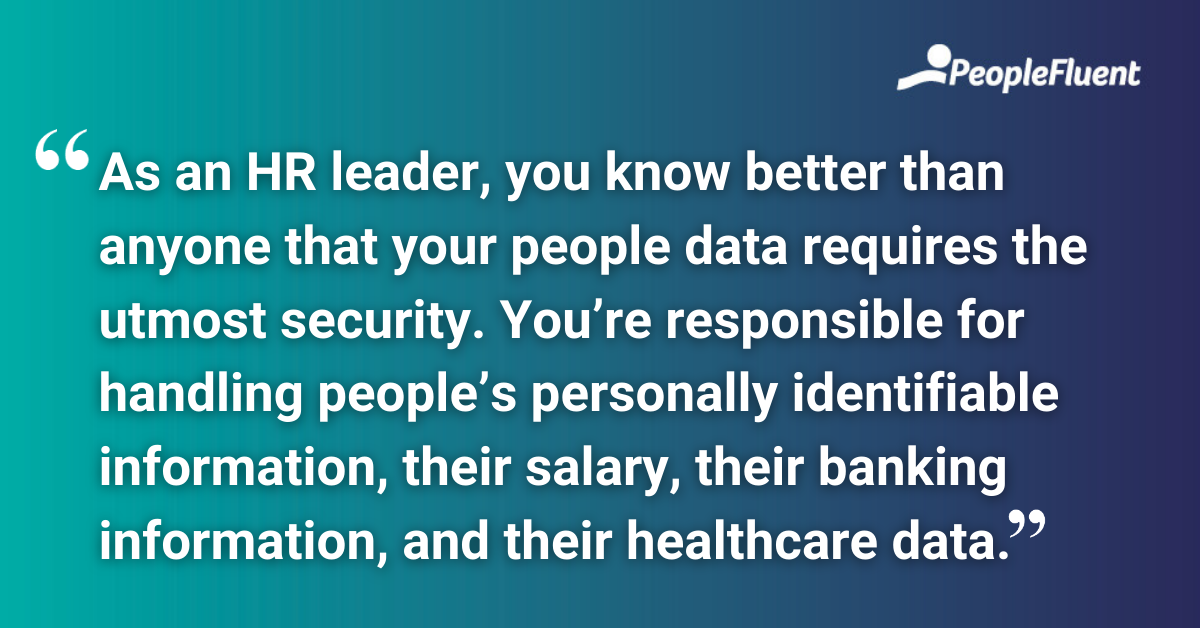Published: Jan 5, 2022Time to read: 5mins Category: Insights
3 Big Ways to Overcome Common People Analytics Obstacles
Data… we’re all sitting on a mountain of it and we know we need it to make smarter decisions. In fact, one survey of L&D leaders showed that 89% believe data literacy is a high business priority.But the truth is many of us don’t know how. At PeopleFluent, we see three common barriers to working with people analytics. In this article, we’ll talk you through them and propose a straightforward solution that will help you experience the many benefits of the tech.
While 74% of organizations maintain that HR technology is important to them, data from our research partner Visier shows that only 26% of respondents feel they’re effectively using technology and analytics to improve their teams. Despite the wealth of benefits that technologies like people analytics could bring, some businesses aren’t able to make the most of the tools they have at their disposal.
But why is that?
We see a combination of the following:
- Gaps in the data
- Complicated security concerns
- Employee resistance to big data
Whether you’re faced with one or all of these concerns, they’re issues that can certainly be tackled. Here’s how.

Challenge #1: There Are Gaps in the Data
Some organizations struggle with the data they have. Maybe there isn’t enough to work with. Maybe the types of data they’ve collected were poorly chosen. It’s not uncommon for data to be muddled and unclear. With HR data, this can be caused by gaps in administrative or business processes. HR data deserves to be treated as a high-importance item but more often than not, its processes end up being loosely followed or abandoned altogether.
How to Overcome Data Barriers
The best way to highlight the urgency of fixing these gaps is to expose the impact that unclear data has on decision-making. First, highlight specific instances where this has happened, and treat fixing and following these processes as necessary preparatory work for people analytics. Then make it clear that bringing all your data together from across your organization allows you to see patterns that wouldn’t be obvious from looking at discrete data sets in isolated systems.
You should look to build your people data capability and systems with this in mind, as there are clear benefits to both HR and finance if both professions can use the same data in your decision-making processes. Emphasize how having all of your departments read from the same page is a far more effective organizational tool than having them read from different books. Low access levels can be overcome with increased uptake of technology systems, and with an emphasis on improving accessibility by ensuring all users are confident in using systems.

YOU MIGHT ALSO LIKE | ‘3 Actionable Steps to Shape Your People Analytics Strategy’
Challenge #2: Securing People’s Data Is Complicated
As an HR leader, you know better than anyone that your people data requires the utmost security. You’re responsible for handling people’s personally identifiable information, their salary, their banking information, and their healthcare data.
How to Address Security Concerns
Transparency is key when implementing new technology. You must work with your privacy officer, IT department, and data governance team to ensure vigilance for bias, privacy violations, and security risks.
Challenge #3: Employee Resistance to Big Data
People analytics is a powerful tool that can provide you insight into your employees’ mindsets. However, that’s possibly more insight than your employees would be comfortable with. Collecting data without thought to the consequences of it can lead to employee resistance. After all, nobody wants to feel they’re being spied on.
How to Create Fairness and Transparency
People analytics can provide an in-depth insight into your organization: what’s working well, what’s not working, and areas for improvement. However, as capabilities become more powerful, so too should your data ethics.

RELATED READING TO DOWNLOAD TODAY | ‘5 Steps to Getting Started With People Analytics: A Data-Driven Approach to How We Manage People at Work’
4 Principles of People Analytics
According to talent industry analyst Josh Bersin, there are four organizational capabilities needed to enable people analytics to be used in an ethical manner. Adhering to these principles will ensure that your data analysis is used to create fairness and transparency.
1) A People-First Mindset
Keeping people—and what’s good for them—at the center of data practices requires a mindset that doesn’t focus too narrowly on process efficiency or cost savings at the expense of employees.
2) A Partnership With IT
Developing new data tools and technologies relies on a good relationship between IT and HR departments. This relationship can also be used to ensure that IT policies are in line with HR policies in a way that maximizes privacy, and the positive impact our technology has on our people. This starts with open communication across functional teams and silos.
3) Communicating Widely and Often
Transparent communication is the basis of trust between teams. By creating an open dialogue about how you’re using your people data and why, you can also empower employees to keep you accountable and provide valuable feedback. This can help fine-tune and improve your people analytics practices.
4) Creating New Specialist Roles
Data literacy has quickly become a nearly indispensable skill for all HR practitioners to have, but there’s already more than enough complexity and scope for full-time HR data specialists to be employed separately.
HANDPICKED FOR YOU | ‘Want to Focus Your People Analytics Strategy? Start With the End in Mind’
Discover how to make people analytics work for your organization
You don’t need to be a data guru or statistician to enjoy the benefits of people analytics—learn more in our full guide filled with advice and best-practice guidelines.